Tricosanthes dioica / ‘Pointed gourd’ / পটোল / পলতা।

General feature: The plant belongs to the Cucurbitaceae family genetically analogous to squash or cucumber. In that way, it is vine by the nature except being perennial. The leaves are heart shaped and grown over the fence or any support. It is considered to be a native of the Indian subcontinent. It is dioecious having both male and female botanical organs within the same plant body. The fruits are dark green with frequent white stripes and the shapes vary from oblong to almost round having 3 to 6 inches in length and 1 – 2 inches in diameter. The flowers are tubular and white and take ~ 20 days to bloom. The botanical name is Tricosanthes dioica (T dioica) whereas in English it is often termed as ‘Pointed gourd’. In India, its name changes by the regions. The plant has tuberous taproots. The cuttings are used for propagation because seeds germinate poorly. In Bengal it is commonly called Patol (পটোল), a fabulously popular vegetable that grows under hot, humid or moderately warm condition in well-drained sandy soil. This vegetable is produced in West Bengal, Assam, Orrissa, Bihar and Uttar Pradesh where it is often cooked to make curry by mixing with spices or occasionally using the fish. The plant parts are used either for cooking or as folk medicines. In that regard, particularly the use of T dioica leaves are noteworthy which bears the name as Palta pata (পলতা পাতা) in Bengali. The fresh green leaves are used to make curry or fried by dipping into the lentil batter. A number of studies were conducted to evaluate its folk medicinal use. The plant shows no toxicity concerning its use as vegetable using leaves, roots, seeds or stems besides the fruits.
Ethno-medicinal uses: The fruits and leaves are frequently consumed as vegetable but cooked in different ways by following regional guidance. The leaves are considered as tonic although it acts as febrifuge and additionally preventing the liver or spleen enlargement. As described by the ancient Indian apothecary literature ‘Charaka Samhita’ leaves are the good antidote for alcoholism and jaundice. It can be used also to alleviate edema and alopecia. Further, it acts as antipyretic, diuretic, cardiotonic as well as laxative. Recent studies and identification of numerous phyto-chemicals confirms the medicinal behavior also finds something more. Following are the few folk uses: A) Leaves are used to hyperacidity; B) Anti-parasitic, B) Anti-periodic, C) Febrifuge, D) Anti-coagulants, E) Blood purifiers, F) Antiseptic, G) Tonic. The fruits improve appetite and digestion.
Several traditional uses of T dioica / Patol (পটোল)
| Country | Region | Plant parts | Use |
| Bangladesh | Fruit | Treating teeth, fungal infection in nail, bad
Smell in mouth |
|
| Leaf | Acidity and constipation | ||
| India | West Bengal | Fruit | Treating chicken pox and its scar |
| Leaf | Diarrhea | ||
| Orissa | Fruit | Tonic, Febrifuge, Skin disease, Spermatorrhea,
Laxative, Enlargement liver & spleen. |
|
| Leaf | Alopecia, fever, hemorrhage, fistula, leprosy,
Erysipelas, diseases of mouth, inflammation, Wounds and expectorant. |
||
| Root |
Febrifuge, Cathartic, Tonic, ascites, anasarca. |
Phytochemicals and its physiologic role: Each part of the plant is a large source of numerous phytochemicals which are identified as, peptides like Trichosanthin, lectin, several triterpenes eg, Curcurbitacin B, Euphol, α – Amyrin, β – Amyrin, Lupeol, Traxerol, Betulin, Karounidiol, Sterols, Steroidal saponins, Tannin and flavonoids.
Trichosanthin (TCS) is the most notable component among all of them. It is a type -1 ribosome inactivating protein (RIP), 24-kDa molecular weight containing ~ 247 amino acids. It inactivates the ribosome by site specific cleaving of N – C glycosidic linkage preventing elongation factor for binding to the 60S ribosomal unit exerting an arrest of protein synthesis. TCS prevents HIV by increasing CD4+ T cells in virus infected patients. It enables to prevent Hepatitis B and tumor growth while exerting apoptosis in numerous cancer cell lines by activating caspase – 3 and -8 pathways increasing intracellular ROS causing cell cycle arrest at the G1 phase. During that act intracellular Ca+2 level goes up with simultaneous lowering of cAMP and PKC subsequently inhibiting the telomerase activity. It could be the reasons involved in the anticancer act. Further, the peptide inhibits tumor migration and angiogenesis in nude mice showing no side effects. Among the affected cancer cell lines are cervical, breast, prostate, lung, prostate, choriocarcinoma, melanoma, colon, hepatoma, stomach, lymphoma and several others. The peptide also acts as a potent abortifacient and immune suppressant.
Besides the TCS, large reserve of sterols, tetra cyclic and pentacyclic triterpenes have been identified and characterized in the roots, seeds and leaves of the plant. The root synthesizes noticeable amount of colocynthin, hentriacontane, cucurbita-5, 24 dienol (saponins) a bitter glycoside and tannins. The fruit contains high level of Ca+2, Mg+2 and Fe+2, nicotinic acid (vitamin – B3), riboflavin (vitamin – B2), vitamin – C, thiamine (vitamin-B1) and serotonin.
Cucurbitacin B is isolated from the T dioica fruit. It is a tetracyclic terpenoid. The compound has been widely studied for its potent anticancer role particularly when administered with low doses of methotrexate or curcumin against multi-drug resistance cancers like human hepatoma. Synergistic effects are observed in both the cases.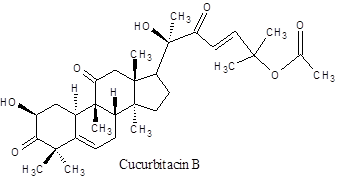
α- & β – Amyrin – The isomers are pentacyclic triterpenes. It is mostly found in the root. They show antimicrobial and antifungal property. Additionally, they also exert anti-nociceptive and anti-inflammatory actions by activating Cannabinoid receptors (CB1 & CB2) while preventing the generation of cytokines and the expression of NF- κβ, CREB and COX-2. Further the β – isomer inhibits the Lipoxygenase actions too.
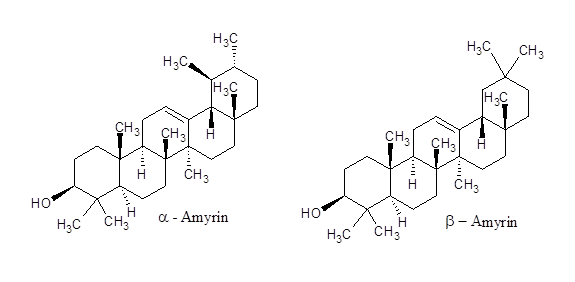
Euphol – It is also a triterpenoid found in the root. It has several biological properties like hypotensive, anticolitis, anti-inflammatory, antinociceptive and antiviral effects. The anti-nociception effect is mediated by its interaction with the cannabinoid receptors, CB1 and CB2. The recent studies further indicate that Euphol has anti-cancer role especially toward breast and gastric cancers by arresting the cell cycle and ERK1/2 mediated apoptosis.
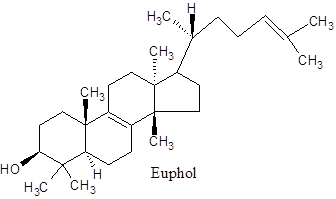
Taraxerol – It is an oleanane (oleanane is a triterpene structure which is the central core of many plant products particularly the triterpene) triterpene isolated from the root of T dioica. The compound possesses strong anti-tumor, anti-inflammatory, antimicrobial and anti-venom (snake) activities. It potently inhibits mammalian sarcoma 180 cell line and few mammary tumors implanted in nude mice. It is further effective against human gastric epithelial cell lines eg, AGS. It is also active against human glioblastoma, U87. The compound induces cell cycle arrest and promote apoptosis. In addition it also induces autophagy and inhibition of cell migration. Besides these, its further action is to inhibit cyclo-oxygenase and acetylcholine esterase and reversing the insulin resistance in adipocytes, 3T3L1.
Lupeol – It is also a triterpene found in many vegetables, fruits and medicinal herbs. It is effective against various ailments like inflammation, arthritis, diabetes, renal problems, cardiovascular problems, microbial infections and hepatic toxicity also against numerous cancers.
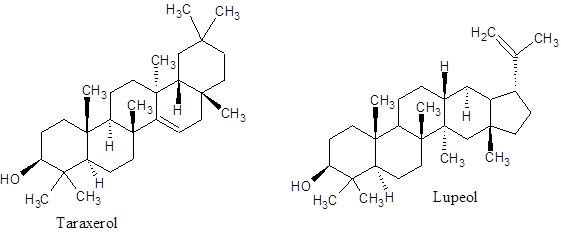
Karounidiol – It is a triterpene of multiflorane type isolated from the seeds. It is very active against tumor promotion when induced by phorbol ester also shoed cytotoxic potential against several tumors especially toward the renal cancer cell lines.
Betulin – It is also a triterpene identified and isolated from the seeds of T dioica. The compound is previously known for its antiseptic and anti-rachitic properties. Afterwards the investigation leads to the fact about its numerous biological effects eg, lowering of cholesterol, anti-inflammatory, hepato-protective, wound healing, anti-tumor and choleretic (stimulation of bile secretion) effects. Studies indicate that its cholesterol reducing property is due to inhibitory action on the maturity of sterol regulatory element-binding protein. Inhibition of this protein lowers the cholesterol synthesis. In that way, it reduces atherosclerosis. As per further action, it enhances insulin synthesis.
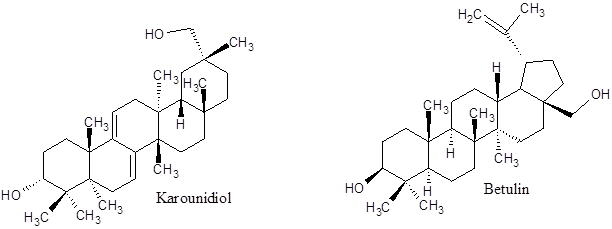
Important sterols – Appreciable number of sterols have been isolated particularly from the roots of T dioica. Among those 24 – methyl-cholesterol and 28 –isofucosterol appear to be the most important ones. They have antibacterial activity against many particularly effective for Bacillus spp. (spore forming bacteria) and Ochrobactrum pseudogrignonese.

Major phyto-compounds identified in T dioica.
| Parts of plant | Compound | Nature |
| Root | Euphol | Triterpene |
| Root | Tirucallol | Triterpene |
| Root | Cycloartanol | Triterpene |
| Root | Taraxerol | Triterpene |
| Root | β- amyrin | Triterpene |
| Root | Butyerospermol | Triterpene |
| Root | Isomultiflorenol | Triterpene |
| Root | 24 – methylene – 24 – dihydro-
lanosterol |
Triterpene |
| Root | α- amyrin | Triterpene |
| Root | Lupeol | Triterpene |
| Root | 24 – methylene-24-dihydro-
parkeol |
Triterpene |
| Root | 24 –methylene-cycloartanol | Triterpene |
| Root | Multiflorenol | Triterpene |
| Seed | 7-oxo-dihydro-karounidiol-
3-benzoate |
Triterpene |
| Seed | Karounidiol-3-benzoate | Triterpene |
| Seed | Karounidiol | Triterpene |
| Seed | 7-oxo-dihydro-karounidiol | Triterpene |
| Seed | Betulin | Triterpene |
| Seed | 29 – hydroxy- | Triterpene |
| Seed | Cucurabita-5,24-dienol | Triterpene |
| Root | 24-methyl-cholesterol | Sterol |
| Root | 24-methylene-cholesterol | Sterol |
| Root | 24-methyl cholesta-7,22-dienol | Sterol |
| Root | 24-ethyl cholesta-5,22-dienol | Sterol |
| Root | 24-ethyl cholesta-5,22,25-trienol | Sterol |
| Root | 24-ethylcholesta-8,22-dienol | Sterol |
| Root | 24-methylenecholest-7-enol | Sterol |
| Root | 24-ethyl-cholesterol | Sterol |
| Root | 24-ethylcholesta-8,22,25-trienol | Sterol |
| Root | 24-ethylcholesta-5,25-dienol | Sterol |
| Root | 24-ethylcholesta-7,22-dienol | Sterol |
| Root | 24-ethylcholesta-7,22,25-trienol | Sterol |
| Root | 28-Isofucosterol | Sterol |
| Root | 24-ethylcholest-7-enol | Sterol |
| Root | 24-ethylcholesta-7,25-dienol | Sterol |
| Root | 28-Isoavenasterol | Sterol |
| Root | Avenasterol | Sterol |
| Root | Colocynthin | Gylcoside |
| Root | Trichosanthin | Protein |
| Fruit | Cucurbitacin | Triterpene |
| Fruit | Vitamin A | Vitamins |
| Fruit | Vitamin C | Vitamins |
| Fruit | Nicotinic acid | Vitamins |
| Fruit | Riboflavin | Vitamins |
| Fruit | Thiamine | Vitamins |
| Fruit | Serotonin | Miscellaneous |
| Fruit | Carotene | Miscellaneous |
| Leaf | 24-α-ethyl-20-ene-hydro-stimasterol
-8β-:14β-di-3-O-β-D-xylo-furanoside |
Saponin |
Pharmacological actions: Numerous pharmacological effects concerning different parts of T dioica plant are already extensively studied both in vivo and in vitro. Number of cases of human studies are also officially reported. The major pharmacological actions which are studied are given below.
Anti-hyperglycemic effect – The effect has been tested in animal models using Streptozotocin induced diabetic rats. By administering the fruit extract, a significant lowering of blood glucose levels has been observed in fasting (~ 29 %) and postprandial conditions (~ 31%). Additionally, reduction in the level of AST (23 %), ALT (37 %) and ALP (35 %) and serum creatinine (36 %) are also noticed. Almost identical results are seen while using the seed extract. The leaves of T dioica produces near similar results but the effect is more pronounced in case of mild diabetic rats. In that case, the glucose level is dropped by 41% for fasting and 87 % for postprandial condition. Further, leaf and fruit extract cause considerable loss in the body weight.
Anti-hyperlipidemic effect – In animal experiments using the rabbits, the oral administration of aqueous fruit extract showed strong hypocholesteremia and hypotriglyceremic effect. The total cholesterol level is decreased by 57 % whereas the triglycerol is reduced by 19 % and the HDL is enhanced by 33 %.
Antitumor effect – The root extract at high doses showed significant anti-tumor activity which is possibly due to anti-oxidant behavior. The presence of Trichosanthin is presumably the underlying cause.
Anti-inflammatory action – The extract of T dioica stem and leaves by ethyl-acetate, methanol or chloroform showed potent anti-inflammatory role in animal experiments. The attenuation of TNF- α, COX-2 and NF- κβ are noticed in all cases which is reason behind that anti-inflammatory effect.
Anti-nociception effect – The effect is solely mediated by the triterpenoids present in the plant as evidenced by various animal experiments.
Miscellaneous actions –
A) Anti-oxidant; B) Cytotoxic; C) Hepato-protective, D) Chemo-preventive; E) Immunomodulatory; F) Wound healing; G) Anti-pyretic; H) Anti-fungal; I) Neuro-pharmacological actions; J) Anti-ulcerative.